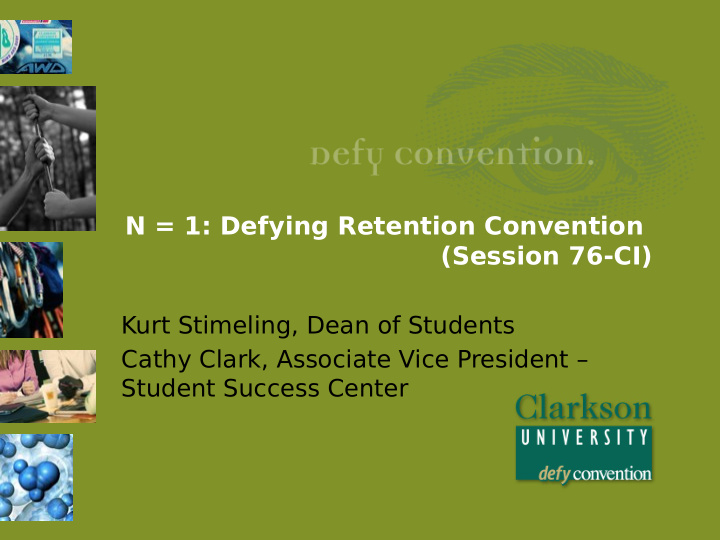



N = 1: Defying Retention Convention (Session 76-CI) Kurt Stimeling, Dean of Students Cathy Clark, Associate Vice President – Student Success Center
Introductions Cathy Clark – Associate VP for Student Success Accommodative Services, Student Support Services, T utoring, Study Skills, Time Management, First Year Seminar Kurt Stimeling – Dean of Students Residence Life, Student Activities & Organizations, Student Center, Student Life and Engagement, Wellness and Campus Safety
Where is Clarkson? Potsdam, NY
Our Campus…
…during many months!
N=1 • Private • 2600 undergraduates • 400 graduate students • 50% engineering • 25% Business • 21% Arts & Sciences • Rural • Research-driven • Division 1 and 3 athletics
N=1
Defy Convention
Our Retention “Problem” First Year to Sophomore Retention = 88% Goal of 92% by 2014
So what’s the problem?
Defy Retention Convention We had to rethink who impacts retention and how they can do it.
5 T arget Populations 1. Overall population of freshmen 2. Separated and readmitted students 3. Incoming “at risk” based on numerous pre-matriculation data 4. Summer Pre-Calculus test scores 5. Late admitted students (last to come fjrst to leave)
3 Overarching Strategies 1. Develop Advising models 2. Reform First-Year curricula 3. Intervention strategies for at-risk students
Advising Models • School of Business ofgers a centralized professional advising • Engineering school advising evolving
FY Curriculum The BIG 3…the Trifecta: Calculus, Chemistry, Physics
Intervention Strategies • Academic Standing & Messages • Fully integrate CSI and RT data across the university to identify all “at-risk” students to make connections to resources • Intervention and recovery plan for students in academic jeopardy.
Intervention strategies: CU connect Mentoring program College student inventory (csi) Calling all Knights
CU Connect Mentoring Why mentor all First-Year students?
Offjces represented
Steps and timing… 1. Meet fjrst week of classes 2. Connect within fjrst month of classes 3. Support: mid-semester 4. Closure: end of semester
Step 1… Meet your students FYS class section FYS Interview Sheet Mentor contact information to students Tracking Mentees through Peoplesoft
College Student Inventory CSI: 3 main categories: 1.Academic Motivation 2.General Coping Skills 3.Receptivity to Support Services Additional background characteristics: •. high school GPA •. hours the student plans to work •. family educational background
Step 2…Connect • Individual meetings to review CSI • Integration and Action Plan
Step 3…support Mid semester check-in individually or in a group. Funds to support activities
Calling All Knights • Contacted all fjrst-year student families at the sixth week of the semester. • Callers were student peer mentors, peer educators, RA’s and Knightline callers.
Results… Fall 2009 Conversations Left messages/Responded Follow up 299 348/25 45 Fall 2010 Conversations Left messages/Responded Follow up 236 302/5 15
Step 4…closure • Wrap up communication via email • Evaluation to student and mentor • President’s Recognition
CU Connect feedback Do you feel you and your mentor made a connection? 268 = YES, 69 = NO, 22 = “OTHER” • “Yes, I do feel that I made a connection with my stafg mentor. She is a great woman and actually helped me get an on- campus job and was easy to talk to. It was great.” • “Yeah, we tight” • “So far, I have not contacted my mentor, but the idea of having one is good because there is someone to go to if I need to.” • “I feel like we made a connection because I emailed her a lot, and every time she would email me back. When I see her around campus she always smiles and asks how I’m doing.”
Please don’t forget to complete your program evaluations. Session 76-CI Kurt Stimeling Cathy Clark
Spring 2011 “Project Success” T argeting true “at risk” students in academic jeopardy. Engineering specifjc changes: experiential course (pilot 11-12)
Recommend
More recommend